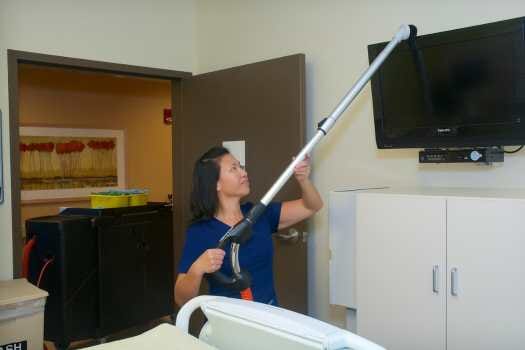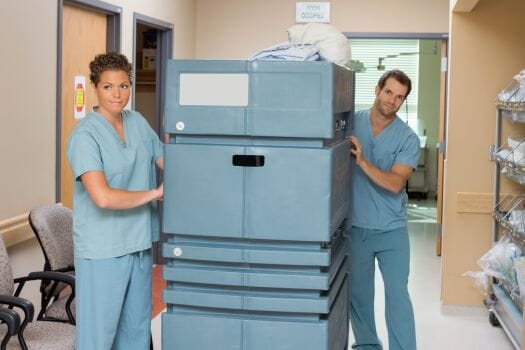Dust removal tools for healthcare
Numerous scientific studies have proven that dust can harbor potential infectious agents. By removing dust with the Xanitos’s XRO vacuum technology from the patient care environment Xanitos removes the potential for disease. Two studies by Veillete et al. and Knibbs et al. reinforce the importance of effective dust removal. The Veilette and Knibbs studies recognized the infection risk of aerosolized dust and aimed to assess the “real-word” effect of existing household vacuum use on dust dissemination and air quality. The stated goal of the studies was not to gauge the optimal performance of vacuums in a controlled environment, but rather to evaluate and understand the actual effect of typical vacuum cleaners on bioaerosols (short for biological aerosol), which is a suspension of airborne particles that contain dust and living organisms such as bacteria and fungi.
The studies included 21 vacuums (18 household vacuums and 3 commercial vacuums) ranging from 6 months to 22 years old, most of which were advertised as HEPA-filtered in the motor and/or exhaust. Dust was not removed from the vacuums prior to testing. None of the 21 used vacuums were tested prior to the analysis for proper maintenance or performance according to specifications i.e. the vacuums were tested on an as-is basis with existing filters in place. It is not known, for instance, whether the vacuum filters had been changed as specified by the manufacturers. The building history of the vacuum cleaner owner's home was also not known, so Veilette et al. were unable to assess the sources of bioaerosols during testing of the vacuums emissions and corresponding source of dust in the filter compartments containing bacteria and molds.
The studies by Veilette et al. and Knibbs. et al demonstrated that vacuum emissions may be a source of bioaerosols. Bioaerosols are complex in source, nature, and diversity and Veilette et al conclude that the vacuum process itself can create bioaerosols in a person’s home. Human skin and hair have been shown to be strong sources of bacteria in floor dust and air indoors, which can be readily re-suspended and inhaled if not removed. Even though the studies focused primarily on household environments, the findings of the studies can be useful for the healthcare environment, in which effective dust removal is of critical importance considering that bioaerosols can lead to severe illness or death.
Dust removal methods in the healthcare environment may also generate such bioaerosols; however, it is of great importance to differentiate between types of dust removal methods. Conventional methods use microfiber dusters or woven fibers claiming that dust will stick to them, but often do not capture much of the dust particles, but rather lead to re-suspension of dust particles creating bioaerosols. These particles then, over an unknown period of time, begin to settle on high and low surfaces. Hence, it is of utmost importance to use the safest dust removal tool available.
Xanitos deploys a state of the art dust removal tool, the XRO vacuum technology, which is unique to the EVS industry providing the key for safe removal of dust from the patient care environment. A clean healthcare environment is vacuuming floors and high surfaces daily to reduce the dust load immediately before it can accumulate, greatly reducing the chances of bioaerosols. The critical component of this XRO vacuum technology is that the vacuum exhaust air is filtered to the finest standard, an ULPA filter, capturing and containing any particles larger than 0.12microns, which includes bacteria and molds. Meticulous maintenance of the XRO vacuum carts and regular replacement of bags and filters ensures that the XRO vacuum carts continue to perform according to their state of the art specifications.
Some companies try to copy this approach, but use poorly filtered vacuums claiming high performance, but actually increase the possibility of spreading infectious disease. This XRO vacuum technology is designed to “scrub” the air in the patient room, as the exhaust air filtered by the ULPA filter is cleaner than the air surrounding the vacuum.
Copycats in the industry cannot provide this unique approach! They do not have ULPA filter capabilities combined with a super quiet vacuum process designed specifically for use patient areas.
As a specialist, Xanitos' fundamental objective is to be at the forefront of the fight against Healthcare Associated Infections while providing the highest quality of housekeeping service available. Connect with our industry experts for more information regarding how your healthcare facilities can improve patient safety, through the utilization of Xanitos' XRO Program
References:
1. Veillettea M, Knibbs LD, Pelletier A, Charlebois R, Blais Lecours P, He C, Morawsk L, Duchaine C. 2013. Microbial Contents of Vacuum Cleaner Bag Dust and Emitted Bioaerosols and Their Implications for Human Exposure Indoors. Applied and Environmental Microbiology Aug 2013
2. Knibbs LD, He C, Duchaine C, Morawska L. 2012. Vacuum cleaner emissions as a source of indoor exposure to airborne particles and bacteria. Environ. Sci. Technol. 46:534–542. CrossRefMedline






